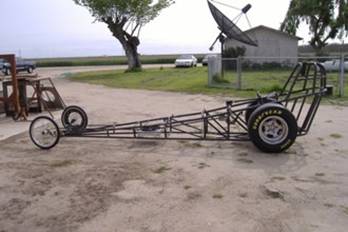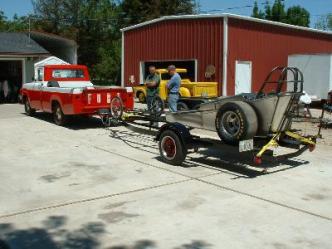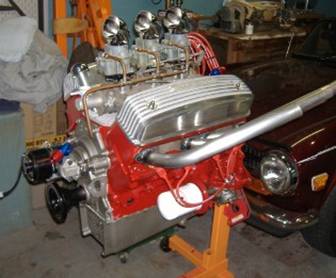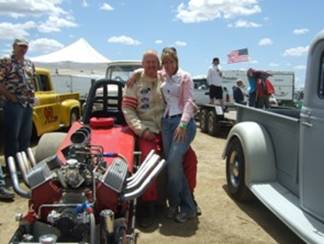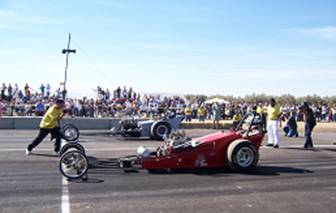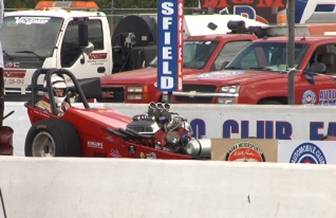
 Elwood: C/Gas
Dragster Build
Elwood: C/Gas
Dragster Build by Tim McMaster
|
Some of the best things in life you come upon by accident.
In November of 2009 I had no idea that by the summer of
2010 I would have my own dragster.
In December last year I was browsing posts on the HAMB (Hot Rod Social Network on the web) and I came across a thread for a new class being opened up for our local nostalgia drag strip, C/Gas Dragster. After reading about this class, I thought to myself, I’ve got to have one of these. With a couple of weeks of research, I decided on a Chassis Research T-440 chassis from the late 1950’s. |
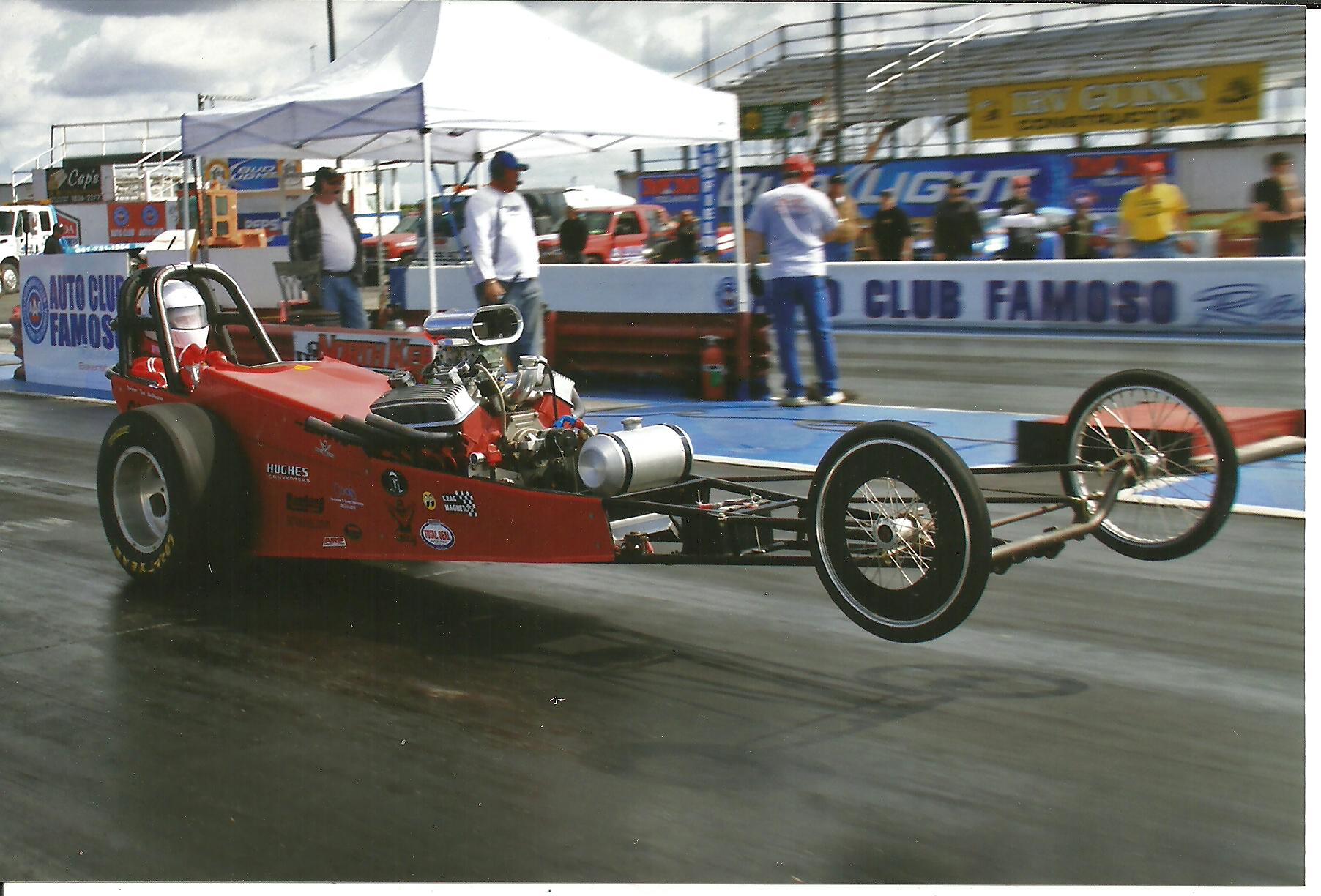 |
|
Many guys on the east coast had been using these in privately organize 1/8 mile drags not sanctioned by the NHRA or ANRA. With this in mind, I went to talk to a friend of mine, a local chassis builder, and told him of my plan. He quickly shot down my idea, saying I would never get it to pass NHRA certification. After arguing a little bit about what I wanted and what he thought I wanted, we came up with a compromise and I purchased a set of blueprints for a front engine dragster (FED) from Mark Williams for $50. The blueprints were for a 200” chassis, but I wanted a 140”. So we used the blueprints for the driver’s compartment, and modified the rest for our purposes. Now its time to start collecting pieces and parts. Some were donated to me (thank you to Charlie Burns). And some took a little searching on the internet. But after a few weeks I had a set of wheels, a Ford 9 inch rear end out of a ‘59 F-100, a steering box from Strange Engineering, and a pile of 4130 chromoly tubing. Time to go to work. During the months of February, March, and April my wife was abandoned on Tuesday and Thursday evenings and all of Saturday, as I was busy at my friends house building a chassis. Did I forget to tell you that this dragster would be powered by a Y-Block Ford V-8? I thought it would be obvious with this article in this magazine. My friend John, the chassis builder, was surprised at my engine choice, but was happy to take on the challenge. With front and rear motor plates fabricated, and a gutted 312 mocked up, a chassis started to take shape around it. The Mark Williams blueprints were made with a “scrub” in mind, of course. A lot of “artistic license” was taken to get the Y-Block to fit. The month of February was very cold in the
east, which is where a lot of my parts were coming from.
S&W Race Cars were providing the front and rear axles, Using a 6” drop Mark Williams front axle we had some decisions to make at how to attach it to our new chassis. All the time this build had been going on, I had been collecting pictures of 1950’s and ‘60s dragsters off the internet for inspiration. A picture of one of Tommy Ivo’s early cars, gave me an idea of how to mount it without front suspension. So we cut the attachments for the radius rods and the torsion bar and fabricated some mounts to the front of the chassis. Now that the front axle and rear end mounts are in place, it’s time to go to work on the roll cage. I wanted a 3 point with a round hoop for a 1960’s look. But again that would not go over well with NHRA, so we decided to go with a 5 point cage as described in the blueprints but tried to make the main hoop as round as possible. In early April we were just about ready to go down on all 4 wheels but since John had the NHRA inspector down to look at another car he was building, we decided to have him inspect my chassis too. It passed with flying colors and I got a nice little sticker saying I was certified for 7.50 seconds. It was time to mock it all up and put it on the ground. So I bolted in the narrowed 9” Ford, installed the pumpkin with 4.33 gears and a spool, slipped the new Strange axles in the housings, attached the 18” spindle mount Akront front wheels, and with the Goodyear dragway specials on 15” slot mags for the rear, we eased the car down to the ground. For the first time in this project I realized I had a race car.
By the first of May I was ready to bring my rolling chassis home for the finishing touches. I forgot to mention back in February I was locking up the shop one evening when I saw a couple of young guys towing what looked to be an old junk 18’ boat trailer down the road. I followed them to the scrap yard, and before they could turn it in, $100 changed hands and I had a trailer with title. With a few modifications this would be perfect for hauling my 140” FED home.
When I got it home it was time to dismantle my race car so it could be painted and then reassembled with the engine and transmission that would motivate it down the 1/8 and ¼ mile. The C in CGas dragster is the engine size. In this class we are limited to 325ci or less. I wanted to get as close to that mark as possible, but I wanted a short stroke engine that would rev quickly. So I decided on a 4” bore and a 3.2” stroke that would give me 322ci. I started with an old 292, bored the cylinders completely out and pressed in 8 1/8” thick wall 4” bore sleeves. The crankshaft I de-stroked from 3.3” to 3.2” by offset grinding the throws to a diameter of 2.099”. I then cut down the counter weights to lighten the crank and cleaned up the edges (knife-edged somewhat) all so the crank would slip through the oil at high rpm. The connecting rods used were a set of 6 3/4” long from a 6 cylinder engine manufactured from a company that will remain nameless and the pistons were Keith Black hypereutectic flat top claimers. All this was balanced to within .5 grams. The heads were a set of posted ECZ-G’s with stainless 2.02” intake and 1.6” exhaust valves, topped off with high ratio rocker arms. Fuel would be delivered through a trio of Holley 94 2-barrel carburetors on top of a Edlebrock 573 intake manifold. (All donated to my cause by Charlie Burns). The burnt gases would then escape through a set of homemade “zoomies”. All this power would be transmitted to the 9” rear with 4.33 gears through a 1969 C-4 that was adapted to the y-Block with a bell housing that was purchased from John Mummert, a very nice item I might add.
Now the car is painted it is time to assemble
it. With only 2 weeks
til the first meet at Eagle Field, I was just barely able to
assemble the car and take it out for a test run at a local airport
taxi way. The car
fired up willingly and felt very strong when I first put my foot
down on the accelerator. But
then came to a quick stop when my brand new electric fuel pump
failed. Thanks again
to Charlie Burns who loaned me a fuel pump from the Yellow Brick.
So I would be ready for Eagle Field but no more time for
testing. Saturday May
22 we loaded up the car and headed for Eagle Field just south of
During the course of the day I got three solo runs in, each with one little problem that was easy to fix, but the fuel pump continued to work and the car continued to make it down the strip every time. I went home that day with a plaque for C/Gas champion. I really shine in a field of one. Drag racing was put on the back burner for the summer as we had bigger fish to fry at Bonneville. But that’s another story for another day. When October rolled around The Eagle Field Hot Rod Gathering was upon us again. So I hauled “Elwood” (what my FED had become known as) back to the 1/8 mile strip with all the bugs worked out of the car. We were ready for some real racing. Over the summer while checking out the engine, I found that my block had cracked on the deck between each cylinder where I had sleeved it. With no time for a remedy I simply pulled the engine and installed a 338ci stroker that I had built for my pick up. This would have to do. There was no problem with my breaking the cubic inch rule because they were just trying to get cars on the field. One guy was running a 350ci Chevy because that was all he had.
I got 4 races in this time. Two against a flat head Ford powered FED. And two against the guy with a 350 Chevy. The flat head I beat soundly both times, one time giving him a large head start. But I’m sorry to say that I lost to the “scrub” both times. This was more because of my reaction time not my Y-Block’s fault. After we launched we stayed neck-in-neck. I was just slightly behind him. Eagle Field does not have a Christmas tree or timing equipment. It is “heads up” drag racing with a flag starter and someone at the end to declare the winner. I had a great time and Elwood performed very well. Everyone is probably wondering what kind of
times and speed my car runs. So
at the end of October, we had a chance to find out by taking
Elwood to Famoso, just north of
One of the things learned at Famoso was that the rear axle ratio was better suited for 1/8 mile than the ¼ mile. This can be seen between the two runs, that while going 3/4 of a second quicker on the ET the top speed was only 2 mph faster. The car is running out of breath before it gets to the end of the 1320. I hope to take care of this during the winter with a set of 4.11 gears. We’ll be out there again in March. I’ve had a very fun year with my new dragster, but what you think at the beginning and what you end up with are two different things. I went into this build with the idea of a small budget, thinking I was going to use a lot of “junkyard parts” such as spindles, axles, hubs, etc., but working with a professional car builder, cooler heads prevailed. And with a little more money laid out, I ended up with a car that was safe and a joy to drive. It’s a lot easier to do it right the first time than to go back and fix mistakes. Special
Thanks to John Krag @ You can see the entire build take place on YouTube when you search "Front Engine Dragster built in five months"
|
|
| Back to Projects | |
